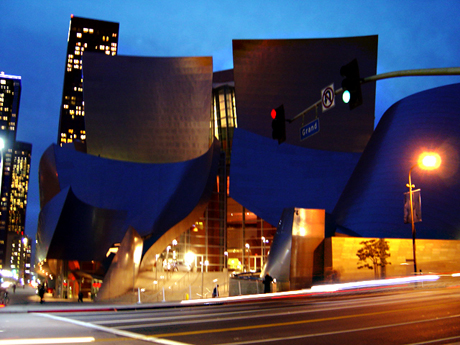Frank Gehry was selected to design the Walt Disney Concert Hall in 1988 and completed the design of the building three years later in 1991. The building has been praised for both its unique architectural form & impressive acoustics when compared to the Hall’s predecessor, hr Dorothy Chandler Pavilion. Construction of the concert hall began in 1999 and was completed in early 2003. It was officially opened on the 23rd October, 2003 and is estimated to have cost $274 million to construct. Much of this money ($100 million) was donated by the Disney family as a tribute to Walt Disney’s devotion to the arts and to the city of Los Angeles, given presence to the Hall’s name. The structure of the building is intend to be separated into smaller segments as to allow it to "speak a different [architectural] language" than the surround architectures. The shapes of the Hall have been derived from sailing and the forms created by sails in the wind. The exterior of the structure is covered in stainless steel panels which due to excessive reflection problems have had to be sanded in some areas. The building is considered to be a Post-Modernist style known as Deconstructivism which is associated with ideas of fragmentation, non-rectilinear forms, manipulated ideas of internal structure versus external structure, and a sense of simulated unpredictability & controlled chaos.
Friday, October 8, 2010
WEEK 10: ANOTHER FRANK GEHRY BUILDING (ARCHITECTURAL CASE STUDY)
Walt Disney Concert Hall
Frank Gehry was selected to design the Walt Disney Concert Hall in 1988 and completed the design of the building three years later in 1991. The building has been praised for both its unique architectural form & impressive acoustics when compared to the Hall’s predecessor, hr Dorothy Chandler Pavilion. Construction of the concert hall began in 1999 and was completed in early 2003. It was officially opened on the 23rd October, 2003 and is estimated to have cost $274 million to construct. Much of this money ($100 million) was donated by the Disney family as a tribute to Walt Disney’s devotion to the arts and to the city of Los Angeles, given presence to the Hall’s name. The structure of the building is intend to be separated into smaller segments as to allow it to "speak a different [architectural] language" than the surround architectures. The shapes of the Hall have been derived from sailing and the forms created by sails in the wind. The exterior of the structure is covered in stainless steel panels which due to excessive reflection problems have had to be sanded in some areas. The building is considered to be a Post-Modernist style known as Deconstructivism which is associated with ideas of fragmentation, non-rectilinear forms, manipulated ideas of internal structure versus external structure, and a sense of simulated unpredictability & controlled chaos.
Frank Gehry was selected to design the Walt Disney Concert Hall in 1988 and completed the design of the building three years later in 1991. The building has been praised for both its unique architectural form & impressive acoustics when compared to the Hall’s predecessor, hr Dorothy Chandler Pavilion. Construction of the concert hall began in 1999 and was completed in early 2003. It was officially opened on the 23rd October, 2003 and is estimated to have cost $274 million to construct. Much of this money ($100 million) was donated by the Disney family as a tribute to Walt Disney’s devotion to the arts and to the city of Los Angeles, given presence to the Hall’s name. The structure of the building is intend to be separated into smaller segments as to allow it to "speak a different [architectural] language" than the surround architectures. The shapes of the Hall have been derived from sailing and the forms created by sails in the wind. The exterior of the structure is covered in stainless steel panels which due to excessive reflection problems have had to be sanded in some areas. The building is considered to be a Post-Modernist style known as Deconstructivism which is associated with ideas of fragmentation, non-rectilinear forms, manipulated ideas of internal structure versus external structure, and a sense of simulated unpredictability & controlled chaos.
Subscribe to:
Post Comments (Atom)






No comments:
Post a Comment